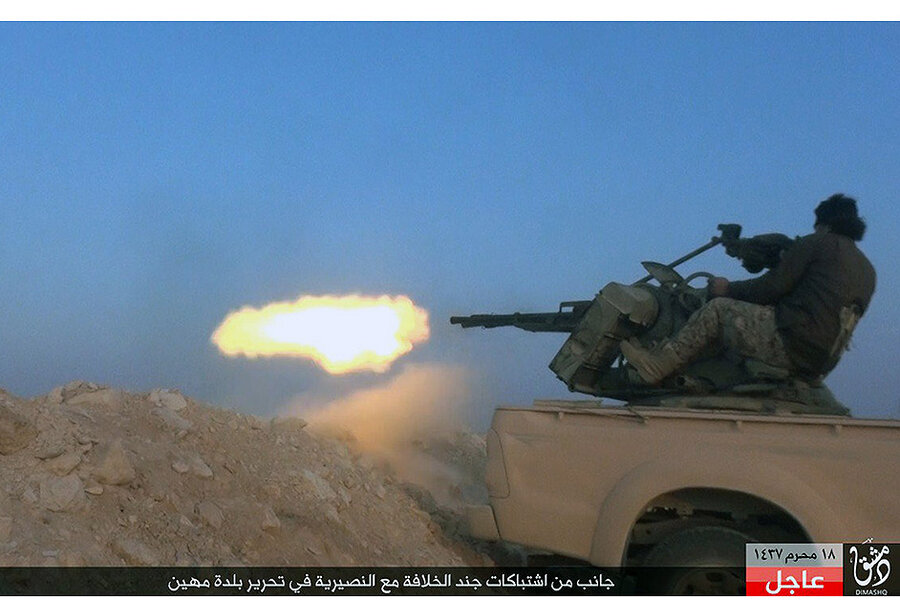ISIS training videos: Why thermal batteries are a threat
Loading...
Videos taken from a captured Islamic State (IS) fighter appear to show that the Islamic terror group's weapons capabilities and training schools are more advanced than previously known, say military experts already concerned about the militants' steady flow of weaponry.
London-based Sky News received more than eight hours of video from an Islamic State "university" from the Syrian Free Army, who captured an IS trainer as he traveled toward Europe. The findings are an "intel gold mine," military advisor Major Chris Hunter told correspondent Stuart Ramsay.
"I think this is one of the most significant intelligence finds in terms of Daesh," Major Hunter told the Sky network, using an alternate Arab name for the Islamic State. "It gives us a very good insight into where they are now, what they're aspiring to do, and crucially, the diversity of the types of threats we might face."
Among the most significant findings is that the terror group has produced a thermal battery used for surface-to-air missiles, which can attack aircraft with near-perfect accuracy. Battery production, which military experts previously considered beyond Islamic State's capabilities, could help recommission old missiles which require the batteries for maintenance.
The discovery comes at a time when the United States and other countries are concerned about their own weapons falling into the Islamic State's hands, often after being abandoned by fleeing Iraqi troops.
"You’ve seen since 2003 pretty much constant conflict, the region is soaking in weapons," an anonymous spokesperson for the UK-based Conflict Armament Research told the International Business Times in November.
According to the research group's report in October 2014, an analysis of small-caliber ammunition cartridges in Iraq and Syria showed that IS's ammunition came from 21 countries, produced from 1945 to today. One quarter of the 1,730 bullet cartridges analyzed were produced in China, nearly one fifth in the Soviet Union (another 9 percent in Russia), and 20 percent in the United States.
Iraqi troops, trained with American dollars and weaponry, have been fiercely criticized for quick retreats from vastly outnumbered IS troops, leaving behind millions of dollars' worth of military equipment. The fall of Mosul, in June 2014, was a particularly costly defeat: the Fiscal Times estimated that $656.4 million was left behind in the form of armored vehicles, tanks, and guns.
Some of that weaponry may be unusable. As Washington Institute for Near East Policy fellow Michael Knights told the Times, much of it may have been destroyed. "This is a no-kidding war," Mr. Knights said, "and in serious wars you lose thousands of vehicles and you lose hundreds of artillery pieces, and the enemy captures it and use it against you."
But others are critical of spending so much on resources likely to help the very force they're meant to fight. "It’s a surreal state of affairs in which American weaponry is being sent into Iraq to destroy American weaponry previously sent into Iraq. If a new sequel to Catch-22 were to be written, this would be the plot line," Reuters' Peter Van Buren wrote last June.
With thermal batteries, IS may now be able to better maintain its surface-to-air missiles, as well.
Videos from the training center, which Sky traced to Raqqa, Syria's former Equestrian Center, also show militants preparing remote-controlled cars with mannequin drivers, outfitted with self-regulating thermostats to convincingly imitate a real driver, and slip through vehicle scans. The cars may be intended as remote-control bombs.
No specific target is mentioned, but the training school may serve a double purpose: preparing militants to fight in Iraq and Syria, while spreading technical knowledge to sympathizers and recruits abroad. According to Sky News, an IS defector with knowledge of the centers confirmed to them that "videoing and documenting this training program was meant for Europe to cause huge damage."
An estimated 12,000 foreign fighters have traveled to Iraq and Syria, according to a December 2015 report from security consultants The Soufan Group, including 3,000 from Western countries. Not all of those fighters join Islamic State. However, the report notes that the "great majority" seem to join "extremist groups," given more moderate rebels' challenges in organizing and fighting effectively.








